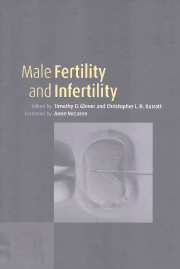Book contents
- Frontmatter
- Contents
- List of contributors
- Foreword by Anne McLaren, FRS
- Preface
- Acknowledgements
- Part 1 Biological perspectives
- 1 The evolution of the sexual arena
- 2 The role of sperm competition in reproduction
- 3 Sperm production and delivery in mammals, including man
- 4 The local control of spermatogenesis
- 5 Some misconceptions of the human epididymis
- 6 Transport of spermatozoa to the egg and fertilization success
- 7 Changes in human male reproductive health
- Part 2 Implications of the new technologies
- Index
6 - Transport of spermatozoa to the egg and fertilization success
from Part 1 - Biological perspectives
Published online by Cambridge University Press: 09 August 2009
- Frontmatter
- Contents
- List of contributors
- Foreword by Anne McLaren, FRS
- Preface
- Acknowledgements
- Part 1 Biological perspectives
- 1 The evolution of the sexual arena
- 2 The role of sperm competition in reproduction
- 3 Sperm production and delivery in mammals, including man
- 4 The local control of spermatogenesis
- 5 Some misconceptions of the human epididymis
- 6 Transport of spermatozoa to the egg and fertilization success
- 7 Changes in human male reproductive health
- Part 2 Implications of the new technologies
- Index
Summary
The primary aim of this chapter is to highlight selected recent developments encompassing the dynamic transport of spermatozoa to the egg and sperm interaction with the egg vestments, emphasizing potential lines for future research. One area specifically explored, in some detail, is the role of calcium in the acrosome reaction (AR). In this section, comparison with our detailed understanding of the role of Ca2+ in the release of neurotramsmitter is used to identify future areas of research that can be explored to further our basic understanding of the AR. In this chapter, little attention is given to fertilization events after sperm–egg fusion, and, for details of this, the interested reader is regerred to several recent reviews (Swann & Lai, 1997; Sakkas et al., 1997). Throughout this chapter we concentrate primarily on data from the human.
How does the spermatozoon reach the egg?
Remarkably, we know very little about the transport of spermatozoa to the fallopian tube in the human. In fact, there are only a handful of studies which have investigated this process in vivo. Usually, such studies have attempted to answer the very basic questions of how many spermatozoa are in the uterus and/or fallopian tube. Such studies were completed in the 1970s and early 1980s and, by their very design, failed to take into account many factors that we now know, at least from other animal data, to affect the transport process. For example, time between sperm recovery and ovulation was often not documented accurately.
- Type
- Chapter
- Information
- Male Fertility and Infertility , pp. 105 - 127Publisher: Cambridge University PressPrint publication year: 1999

